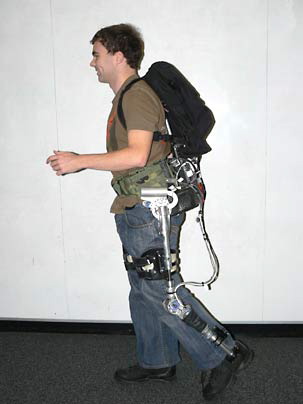They created an exoskeleton for a person, which takes on 80% of the weight carried

Researchers at the Media Biomechanotronics Laboratory's group have created a device capable of lightening the load for soldiers and other people carrying heavy equipment.
Their invention, known as an 'exo-skeleton', can support a significant portion of the weight of a heavy backpack, and transfer that weight directly to the ground. In this way, the weight is removed from the back of the person carrying the device.
The researchers reported in September, in the International Journal of Humanoid Robotics, that the prototype they created can successfully take about eighty percent of a 40-kilogram load carried on a person's back. But there is still one problem: the current model disrupts the normal way of walking of the person carrying it.
"You can literally feel it [the prototype] affecting your walk," said Connor Walsh, a graduate student who worked on the project. At the same time - "you still feel it lightens the weight, and you definitely feel less pressure on the upper body."
The research group was headed by Yogo Herr, principal researcher in the biomechatronics group and associate professor at the MIT Media Lab - Massachusetts Institute of Technology. Earlier this summer, Herr and his colleagues unveiled the world's first robotic ankle, designed for lower limb amputees.
Ultimately, Herr hopes to create assistive leg devices that can be useful to everyone. He envisions exoskeletons for legs that could help people run effortlessly, as well as help carry heavy loads.
"Our dream is that 20 years from now, people will no longer go to bike shops - they will go to foot shops," he says.
Exoskeleton devices can increase the weight a person can carry, decrease the likelihood of a leg or back injury, and reduce the weight or level of difficulty a person feels in carrying a heavy weight.
The person wearing the exoskeleton puts their feet in boots connected to a series of tubes. "The pipes run parallel to the leg up to the backpack, transferring the weight of the backpack to the ground. Springs in the ankle and waist area and restraints in the knee area allow the device to imitate the walking movement of a human leg, at a very low cost of supplying external power (one watt).
Other research groups have successfully produced exoskeleton devices that can support weight, but require a large power source (about 3,000 watts). This power source is provided by a gasoline engine.
When the researchers from MIT tested their device, they found that although the load carried on the tester's back was indeed lightened, the tester had to consume 10% more oxygen than usual. Apparently the reason for this is the need for additional effort to compensate for the disturbance in the walking form.
The group hopes to improve the design so that the exoskeleton better mimics the movements of the human leg, thus enabling a more natural form of walking. The most important result of the study, Walsh says, is that the innovative design - based on springs and low energy consumption - looks promising.
"This is the first time it's been tested," Walsh said, "we didn't know what to expect."
Other members of the biomechatronics group who contributed to the project were Daniel Fluske, Ken Pesch, Andrew Valianta, and William Grand.
Image - Connor Walsh demonstrates the exoskeleton prototype he and other researchers at MIT developed. The invention can successfully carry 80% of a weight of 40 kilograms, carried on the tester's back.

6 תגובות
I hope that a person who takes (even if it is with the help of a robot) a weight greater than 40 kilos, will not fall forward... because in the present model, he could be seriously injured!
By the way, shoes that generate electricity is good.. why not a turbine in the throat to generate electricity from our breath.. but seriously I am a passionate supporter of green energy.. so congratulations for the idea.
Fixed, and thanks for the constructive criticism.
"The pipes run up the leg"
In English, perhaps, the pipes "run". In Hebrew, the pipes go up the leg, or are assembled parallel to the leg.
"Our dream is that people will go to shoe stores instead of buying bicycles in twenty years." The feeling is familiar. This has happened to me in dozens of ideas I've had (none of them passed the stage of writing and sketching or scribbling). The right attitude if he survives at all!!
To me it seems like the lost step (the link) that was not done on the way to developing a robot and precisely there it has a good chance to be integrated into robotics that is gaining momentum...therefore there is more chance that in twenty years people will have a robot assistant that will carry the load! When they travel for pleasure on sophisticated bicycles equipped with advanced technology!
I owe a small btw... regarding the electricity that the facility needs, my idea from about two years ago of a shoe that generates electricity (by utilizing stepping and walking) could be useful here!!
And by the way, the responses in front of me..are they doing experiments to test the effect directly on the DNA? ? That is, do they reveal d.na. to a different environment from what it was originally built for and check if there is the beginning of an effect and where in what area) is this happening? Or it may occur outside of DNA. !
And by the way, if the legs degenerate, maybe fins will grow or a magnificent tail will grow!!
my people -
I don't think evolution will be able to work in such short time frames. If so, then certainly not without some selective pressure.
Here is the first trigger for the evolutionary leap of limb atrophy. And I don't say this in a negative way, because everything that man does is natural, even if it is robotics.
Ami